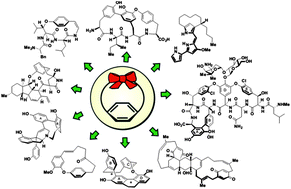Strained cyclophane natural products: Macrocyclization at its limits
Abstract
Covering: up to 2011
Cyclophane natural products comprise an intriguing class of structurally diverse compounds. As inherent for all cyclic compounds regardless of their origin, macrocyclization is naturally the most decisive step, which defines the overall efficiency of the synthetic pathway. Especially in small cyclophane molecules, this key step constitutes an even greater challenge. Due to the strain imparted by the macrocyclic system, free rotation of the benzene ring(s) is often restricted depending on both the constitution of the tether and the aromatic portions. Not surprisingly, the synthesis of natural cyclophanes with their often outstanding pharmaceutical activities and the inherent issues associated with their preparation has attracted much attention among the synthetic community. In particular, it stimulated the development of new strategies for the ring-closing step, as often otherwise well established and robust reactions fail to perform effectively. In this review, we describe the challenges synthetic chemists are facing during the synthesis of this small, but structurally and biologically fascinating class of natural products, concentrating on the representatives exhibiting configurational stability. The main focus will be on the different concepts for the installation of the macrocyclic system, in most cases the central problem in assembling these extremely rigid molecules.


 Please wait while we load your content...
Please wait while we load your content...